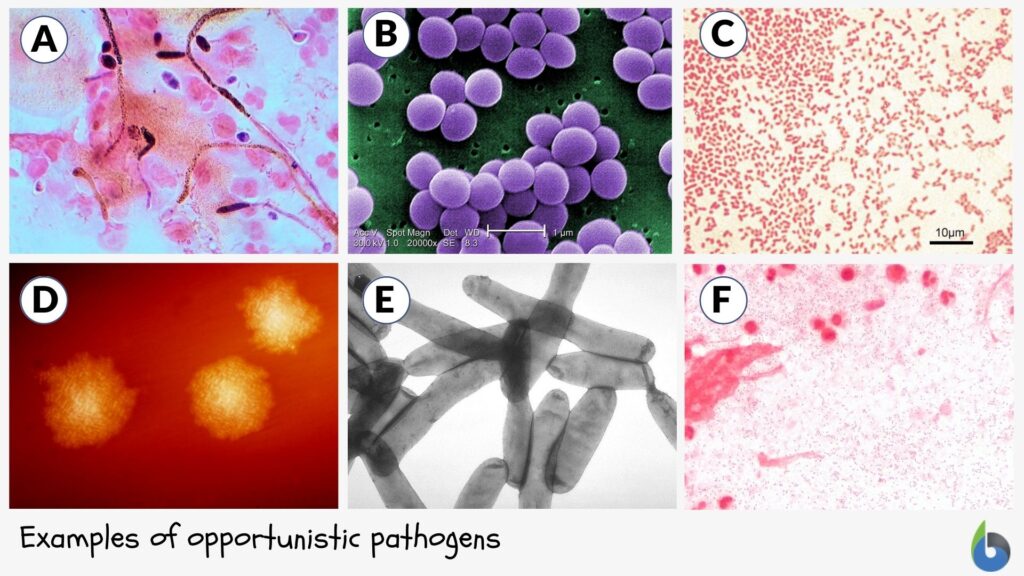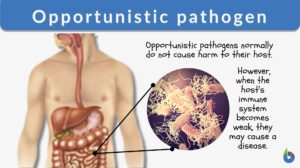
Opportunistic pathogen
n., plural: opportunistic pathogens
[ˌɑpəɹˌtuːˈnɪstɪk ˈpæθəˌdʒɛn]
Definition: normally a commensal but can cause disease to its immunocompromised host
Table of Contents
Opportunistic Pathogen Definition
How do we define opportunistic pathogen? The opportunistic pathogen is an infectious pathogen that is normally commensal in the body but can cause disease when the host’s resistance is altered. They can be some viruses (referred to as “opportunistic viruses”), fungi (referred to as “opportunistic fungi”), parasites (“opportunistic parasites”), and bacteria (“opportunistic bacteria“).
They are normally present in the body without causing disease but cause an infectious disease in certain conditions, such as when the immunological response of the host is low. The low resistance of the body to opportunistic pathogens may occur due to many factors such as malnutrition, HIV, genetic factors, leukopenia (low WBC count), and aging.
The opportunistic organism may exist in the body as a commensal. Let’s take commensal bacteria as an example. But first, let’s define commensal bacteria.
Commensal bacteria are bacteria that do not necessarily cause harm to their host. This type of symbiosis occurring between the bacteria and the host where the host is neither generally harmed nor is benefitting in the relationship is referred to as commensalism. Commensal bacteria are essential to the well-being of humans. Their presence may even aid in the absorption of nutrients.
Moreover, commensal bacteria can prevent the pathogenic invasion of the body and improve the function as well as the development of the immune system. Commensal bacteria produce antimicrobials that resist pathogenic invasion and colonization in the body. Under certain conditions, commensal bacteria may become opportunistic pathogenic bacteria.
Biology definition:
An opportunistic pathogen is an organism that normally does not harm its host but can cause disease especially when the host’s resistance is low. Examples are Candida albicans (an opportunistic agent of oral and genital infections in humans), Staphylococcus aureus (normal flora on human skin but may cause infections), Pseudomonas aeruginosa, (may cause burn and external ear infections).
Variant: (opportunistic) pathogene.
What is an opportunistic disease?
The opportunistic disease occurs mainly due to the suppression of host resistance, which, in turn, is due to the disruption or the absence of the components of the immune system of the host.
Opportunistic pathogens are usually present in healthcare settings as hospitals. Such pathogens cause opportunistic diseases that they do not usually cause under normal conditions. Opportunistic pathogens cause infections by taking advantage of the weakened immunity of the host, disturbance in the normal microbiota, or penetrating barriers as in case of traumas. Moreover, opportunistic pathogens may cause mild infections in healthy individuals. However, the infection may lead to serious complications if the individual’s immunity was disturbed.
Factors that induce a commensal organism to become pathogenic
Disturbance of the host immunity may occur due to the following:
- Administration of immunosuppressants
- Advanced HIV
- Chemotherapy
- Damage of the skin, as in surgeries
- Antibiotic intake resulting in the disruption of the normal flora in the body
HIV affects immunity because the virus can infect the T cells of the immune system. Because the immune system consequently becomes less effective, opportunist pathogens have an opportunity to become infectious. During the later stages of HIV, the host is at high risk of developing meningitis, tuberculosis, and conditions associated with viral infections, e.g., Kaposi’s sarcoma. Thus, opportunistic pathogens represent a major cause of death in AIDS patients.
Opportunistic pathogens are also a major cause of infections and deaths in cancer patients as well as patients receiving organ transplantation. Severe immunocompromised drugs may lead to simultaneous infections with different opportunistic pathogens.
What are the main characters of opportunistic pathogens?
- Normally, they are organisms that are less likely to cause infections and do not act as a true pathogen
- Infections caused by opportunistic pathogens are serious infections and occur due to impaired immunity of the host.
- Opportunistic infections may be clinically different from normal infections of the same pathogen
What are the conditions that may influence the type of an opportunistic infection?
- Impaired immunity
- Surgeries and instrumentation
- Broad-spectrum antibiotics administration
- Damage of an organ or system
How to avoid infections of opportunistic pathogens during periods of low immunity?
- A boost in the immune system. The immunity is restored as soon as possible to reduce the incidence of infections caused by opportunistic pathogens
- Healthy lifestyle and habits. The individual should avoid infectious agents by cooking eggs and meat well, drink pasteurized dairy products, avoid potential sources of infections as infected individuals and hospitals, avoid any contact with feces, dust, or farm animals as they represent a major source of infection.
- Using prophylactic antibiotics. The risk of acquiring opportunistic infections may be reduced by the administration of antibiotic prophylaxis, which is given before surgical incisions.
Opportunistic Pathogen Examples

Let’s get to know the different opportunistic pathogens and opportunistic infections.
Examples of opportunistic microorganisms
Here are examples of opportunistic microorganisms:
- Candida albicans
- Staphylococcus aureus
- Pseudomonas aeruginosa
- Staphylococcus epidermidis
- Haemophilus influenzae
- Streptococcus pyogenes
- Neisseria meningitidis
Common examples of opportunistic infections
Here are examples of opportunistic infections and diseases:
- Candidiasis – the infection caused by a fungus, Candida albicans, which is normal flora in the oral cavity as well as genital organs in humans. However, it may cause infections if the host immunity is low.
- Staph infections – by Staphylococcus aureus. This bacterial agent covers the skin of humans but may cause opportunistic staph infections when present in internal devices such as prosthetic joints and intravenous lines. Staph infection may lead to severe sepsis.
- Pseudomonas aeruginosa infections – usually, this bacterial species colonizes medical devices such as catheters. It is the most common cause of external ear infections, burn infections, and respiratory infections. It is usually associated with hospital infections and cystic fibrosis.
- Clostridium difficile opportunistic infections –in gastrointestinal tract, especially in the form of nosocomial infection.
- Legionnaire’s disease – by Legionella pneumophila, a bacterium that may cause respiratory infection.
- The normal flora in the pharynx and nose in the upper respiratory tract may carry pathogenic microorganisms without the appearance of symptoms. These opportunistic infections usually occur after the damage of the epithelium following a viral infection in the respiratory tract.
- The gastrointestinal tract contains several strains of microorganisms in different regions from the mouth to the small intestine to the anus. Under normal circumstances, these colonizing microorganisms are harmless. In fact, they are essential for our health. On the other hand, the bacteria can become opportunistic pathogens if damage occurs in the bowel. Opportunistic pathogens may cause peritonitis that may develop intra-abdominal abscesses and finally lead to sepsis. In order to prevent that, prophylactic antibiotics are given to patients undergoing abdominal surgeries to minimize the risk of developing an opportunistic infection.
Another type of opportunistic infection that may occur in the gut results from the administration of antibiotics for the treatment of infections caused by the “true pathogens”. Antibiotics can also harm the normal flora in the gut causing diarrhea because the normal flora maintains the normal bowel movement. Moreover, the loss of microbial flora will allow the colonization of other pathogenic strains in the gut.
Try to answer the quiz below to check what you have learned so far about opportunistic pathogens.
References
- Baron, S., Fons, M., & Albrecht, T. (1996). Normal flora. Medical Microbiology. 4th edition.
- Content Source: HIV.govDate last updated: July 16, 2019. (2021, April 8). Opportunistic infections. HIV.gov. https://www.hiv.gov/hiv-basics/staying-in-hiv-care/other-related-health-issues/opportunistic-infections.
- Examples of diseases caused by opportunistic pathogens. FutureLearn. (n.d.). https://www.futurelearn.com/info/courses/infection-control-antimicrobial-resistance/0/steps/32005.
- Shanson, D. C. (2014). Microbiology in clinical practice. Butterworth-Heinemann.
- Söderholm, J. D. (2012). Effects of Stress on Intestinal Mucosal Functions. In Physiology of the gastrointestinal tract (pp. 1979-2000). Academic Press.
©BiologyOnline.com. Content provided and moderated by Biology Online Editors.








